Orchid dries: why and what to do?
Orchid - such a plant to which you need to find a special approach. Each of the representatives of this species has its own characteristics. One is good to sit in the sun and water into a pan, while the other should be rearranged in partial shade and irrigated by pouring water into the pot. It is recommended to know, in case the orchid dries, what to do in order not to lose a beautiful flower.
Content:
- Orchid: description and varieties
- Orchid dries: causes and possible diseases
- What to do, how to cure a plant?
- Helpful tips: how to properly care for an orchid
Orchid: description and varieties
The family of orchids boasts a variety of colors, not only in species quality, but also in size and color. Today there are about 30 thousand different varieties. A beautiful flower - exotic in our area, originates from China and Japan. In living nature, they are presented in most cases as epiphytes, but there are also shrub orchids and lianas, which tend to lignify.
Epiphytic orchids entwine other trees, using them as a support. Interestingly, the vine does not feed on the tree sap from the plant on which it sits. They only absorb nutritional properties from the humus layer, which settles on the crown, branches and bark of the host tree. And its long aerial roots draw in the necessary moisture and missing useful elements from the tropical humid air.
The stem of an exotic flower is erect, depending on the species, it can be long or short. The peduncle has a green structure. The leaves are usually fleshy, broad and matte.
The diversity of the Orchid family is so numerous that several generalized varieties have been identified:
- Phalaenopsis - the most common type. Its name is taken from the Greek language and means "moth". This name is given due to the external resemblance of the flower to the wings of a butterfly. If you know how to handle this type of orchid, then caring for it at home will not be difficult. Its distinctive feature is flowering several times a year, as well as significant volumes of buds produced. The color of the species is so diverse that they distinguish not only yellow, pink, white and purple tones, but also blue, red, blue and even black colors.
- Dracula - Unlike ordinary orchids, which are pollinated only by insects, it can be pollinated by shrews and bats. It got its name because of its appearance, which is very similar to the open mouth of a little dragon. Naturally, the color of the variety does not differ in originality, but varies in tones of black.
- Cattleya - represents a fairly large volume of flower produced. An interesting point in this form is the protruding lower lip of the inflorescence with corrugated edges. In addition, the leaves of this representative of beautiful creatures are coated with wax.
- Pafiopedilum - its appearance resembles a woman's shoe. Each flower in a single copy is presented on the bush. A distinctive feature of the flower is a different shade of foliage, ranging from a monochromatic light green color to dark shades with a black border.
- Vanda - tall and massive species varieties, stretching up to 80 cm in height.Their flowers are quite bright, have a fragrant smell, but at the same time have a flat structure. The color palette of inflorescences is varied.
- Dendrobium - plant height can vary from 30 to 60 cm in height. It boasts giant flowers, reaching 7-10 cm in diameter. The color is quite varied.
Thus, orchid Is a flower that can appear not only with an original and unique color, but also be distinguished by its appearance.
Orchid dries: causes and possible diseases
The reasons for the drying of the plant can be various factors. In this matter, one should not panic, it is better to examine the green friend and identify possible signs of the disease. After that, you should start resuscitating your pet.
There are moments in the life of an orchid when the lower one or two leaves at once begin to fade right before our eyes. Do not panic - this is a natural process, the leaves have existed in their life cycle, now, as they wither, they give up all the nutrients to the young greenery and die off.
If all the leaves of a recently healthy shrub have sharply withered, and the buds have dried up and fell off, you should "sound the alarm."
Possible symptoms of the disease and the reasons for their occurrence:
- The inflorescences do not open, dry up and fall off - an elevated temperature or, conversely, a constant draft, dry air without moisture and little lighting.
- Flowers become covered with white spots and insignificant dots, die off - lack of ventilation, root rot, dampness and low air degrees.
- Lack of flowering and drying out are unfavorable conditions in temperature conditions.
- Withering of roots - excessive watering, stagnation of water, as a result of decay root system.
- Drying of the roots outside the pot - mechanical damage, accidental breakage of the green shoot.
- Loss of color, thickness and green appearance of the roots inside the pot - insufficient watering, use of hard water.
- Decay of the root system - waterlogging at low temperatures.
If the plant has no other visible reasons, then all of the listed symptoms can be easily removed and the flower will begin to smell fragrant again. Otherwise, in the presence of other symptoms characteristic of diseases, the orchid urgently needs to be isolated from the rest of the collection. If you do not do this, you can infect all shrubs located nearby.
The orchid tends to acquire various diseases:
- Root Rot - Roots begin to mold, rot, decompose, crack, or simply turn yellow. The green part of the bush will dry out sharply at this moment.
- Tracheomycosis - wilting is manifested, but not of all foliage, but in part, rotting of the base of the plant is observed, the development of roots slows down.
- The appearance of mottling on leaves or flowers - rust, powdery mildew, cercosporosis, anthracnose, stangosporosis, septoria, phyllostictosis.
Any disease is curable in the early stages. Be sure to treat the inhabitant of the windowsill with an insecticide. But it is worth noting that the chemical agent should not be of a preventive nature, but fighting the disease.
What to do, how to cure a plant?
If the identified reason is inadequate care, then it is recommended to establish appropriate conditions for a comfortable stay:
- In case of overheating in direct sunlight, the flowerpot should be moved to a cooler room with darkened or diffused light. Duration of isolation is 3-4 hours. During this period of time, no additional watering or spraying is required. After the passage of time, the pot with the pet is placed in a lighted place, but where direct streams of light do not reach.
- The plant dries up, and at the slightest touch it walks in a flowerpot - these are signs of a banal lack of watering. The pot is placed in a bowl of warm room water for half an hour - maximum an hour.Spraying can be applied, but at the same time make sure that water does not fall on the peduncle and on the growing point.
- There are times when mechanical damage to the roots occurs. It is a little difficult to restore the appearance in this case. Complete root therapy is required. The flower is carefully removed from its familiar place and examined for signs of decay or drying of the roots. If necessary, the damaged areas are removed with a sharp disinfected instrument. The cut is immediately sprinkled with crushed activated carbon, cinnamon or wood ash. The old substrate is removed, and the new one is poured into the flowerpot.
- Do not get carried away with the introduction of a mineral supplement. It is bad when there is a lot of fertilizers. Leaves become lethargic, there is a tendency to dry out. In this case, you should take out the exotic guest and rinse the root system thoroughly for him. Inspect roots for damage and change soil.
After that, the plant should be allowed to rest by placing it in a completely darkened room, do not water or ventilate. In this state, the flower will quickly gain strength, and again will delight with its blooming appearance.
Helpful tips: how to properly care for an orchid
In order not to repeat mistakes and the plant again does not acquire a yellow, faded, painful appearance, you should only follow some rules for caring for a capricious exotic representative:
- Do not expose to direct sunlight, especially on the southern windows, the east or west sides are ideal for the beauty.
- In the summer months, when the sun is most bright and baking, it is recommended to shade the flower or rearrange it to another habitat.
- For a decorative vine to grow well and feel healthy, lighting takes about 12 hours. In winter, it is advisable to supplement lighting with special lamps.
- The optimum temperature for a comfortable stay in the daytime is + 18 + 27 C, and at night the decrease in air degrees should not be lower than 13 C. But the temperature difference is especially important for the normal life of the exotic.
- It is imperative to ventilate the room where the orchid is located. This process will allow the roots to ventilate, perform the function of thermoregulation and saturate the soil substrate with fresh oxygen.
- For most types of orchids, an appropriate humidity is needed - at least 40-50%. If there is insufficient moisture, especially in the heat or when the batteries are on, it is worth spraying the shrub at least 2 times a day.
- The flowerpot in which the beauty is located should allow air to pass through as much as possible.
- Watering should be carried out as the roots dry inside the pot. If the roots look bright light green, saturated with water, then additional irrigation is not required. If they are wrinkled and pale, then the time has come for good watering. The water should be soft, not hard, preferably settled. It is worth moistening in a pan, the roots will independently collect as much moisture as they need. The rest will be absorbed by the air roots.
Thus, it is recommended to be sure to monitor the condition orchids and at the first signs of illness, take rescue measures as soon as possible. It is advisable to familiarize yourself with the rules for caring for a delicate pet after buying a flower.
More information can be found in the video:



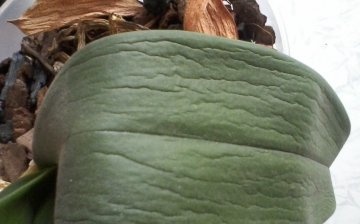

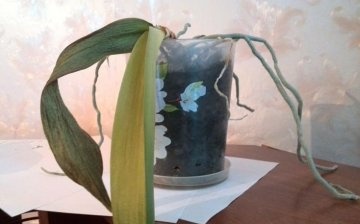
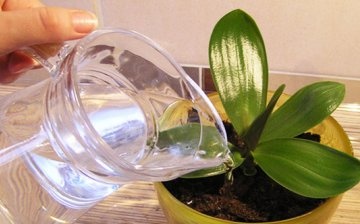







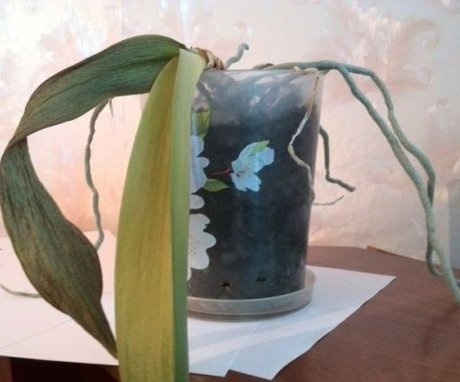
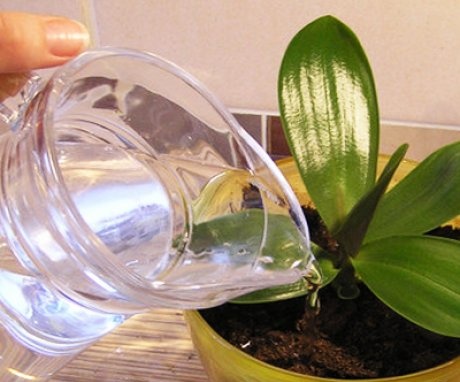
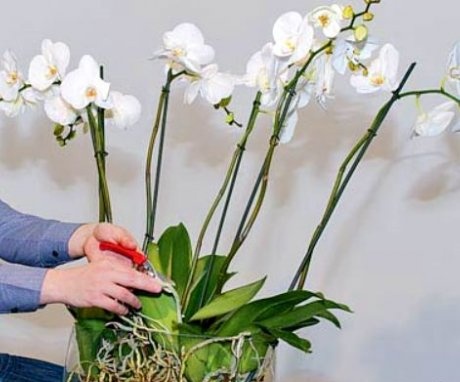
If the orchid begins to dry, then this is due to weak, or vice versa, strong watering and a lack of fertilizers. Therefore, with any agronomist, select the required fertilizers, the location of the pot with flowers by the window, that is, the windows should face in a certain direction.